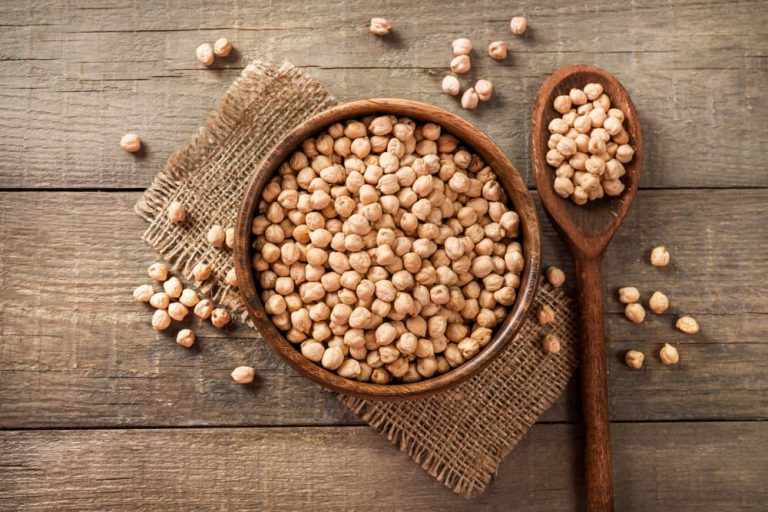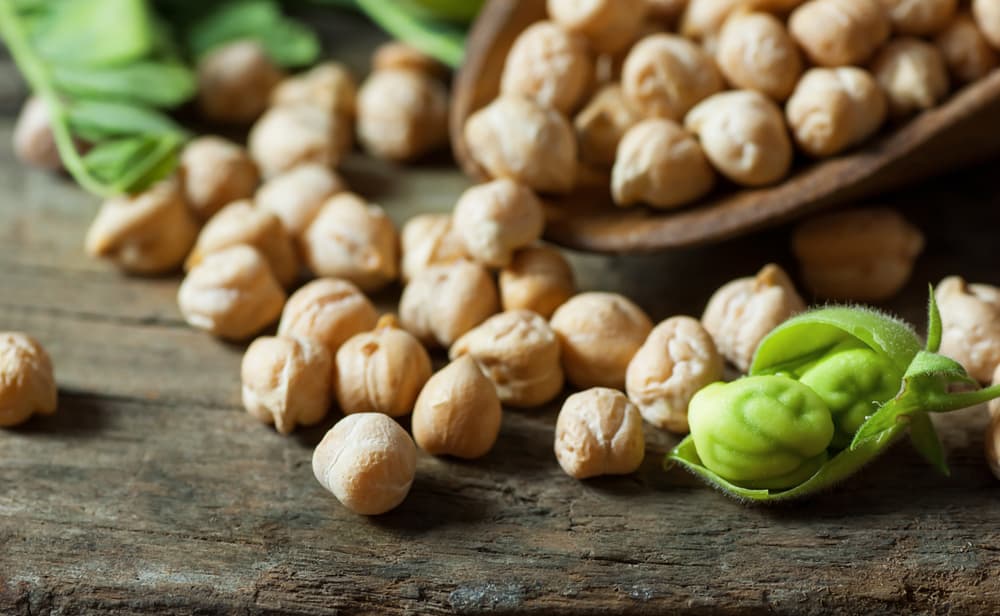Can Dogs Eat Chickpeas?

Chickpeas, also known as garbanzo beans, are seeds from the legume family, and are related to peas, beans, and lentils. They have been used in Mediterranean, Middle Eastern, and Indian cuisine for centuries.
Chickpeas can be purchased in most stores—either dried or canned in water or brine. You will also come across chickpea products such as hummus (which is made from blended chickpeas) and gram flour (dried and ground chickpeas).
Chickpeas are high in protein, which makes them a popular ingredient for those eating vegetarian or vegan diets. But can dogs eat chickpeas? Let’s take a look…
Can Dogs Have Chickpeas?
The good news is that chickpeas are safe for dogs to eat. In fact, they’re becoming a popular ingredient in pet foods, usually as a carbohydrate replacement in grain-free foods.
In 2017, a survey of pet foods available in the U.S. found that over 11 percent of dry dog foods and 2 percent of wet dog foods included chickpeas. So, chickpeas—at least in most forms—are definitely safe for dogs to eat.
Benefits of Chickpeas for Dogs

So now we know chickpeas are safe for dogs, the next question is whether they’re a healthy addition to dog diets.
According to the USDA FoodData Central database, chickpeas contain nearly 9 grams of protein and 8 grams of fiber per 100g product, making them a high-protein, high-fiber vegetable. The rest of the weight of chickpea comes as carbohydrates and water, with only a very small amount of fat.
Chickpeas contain vitamins and minerals too—magnesium, potassium, copper, calcium, Vitamin A and B-complex vitamins are all present in varying amounts. This means chickpeas are not only safe, they’re a relatively healthy option for dogs to eat.
Since chickpeas contain so much protein, it’s common for people to ask if dogs can be on a vegan diet if they eat chickpeas. However, although they pack a protein punch, chickpeas don’t necessarily have the right amino acids—the building blocks of protein—to make them suitable as a sole protein for dogs. For example, chickpeas are lacking in methionine, and only contain low levels of cysteine, both of which are essential for dogs. Chickpeas therefore should never be your dog’s only protein source.
In commercial dog food, chickpeas tend to be most frequently added to grain-free dry diets. During processing, traditional grains provide starch and structure that help the kibble to form. With a grain-free food, this function is performed by legumes like chickpeas. So, although the diet will take into account the protein, fiber, and micronutrients provided by chickpeas, they’re likely present for their starch content.
How to Feed Chickpeas to Dogs

If you think chickpeas for dogs sounds like a great idea, you’ll want to know how best to feed them to your dog. Of course, the simplest way to feed your dog chickpeas is to buy a diet that includes them in the ingredients list. But if you’re looking to add chickpeas as a snack or treat, you’ll have to get a bit more inventive.
You can add chickpeas to your dog’s food, or use them as a training treat—they’re the perfect size! However, it’s important to be snack savvy when it comes to your pet and follow the golden rules outlined below.
Precautions When Feeding Chickpeas to Dogs
If you decide to feed your dog chickpeas, there are a few things you need to be aware of.
First, you should only ever feed cooked chickpeas. Dried chickpeas are difficult to eat and can cause illness, so cook dried chickpeas before feeding or stick to canned chickpea options.
When feeding canned chickpeas to dogs, check the label carefully. Some canned chickpeas are packaged in brine, which contains too much excess salt for dogs. Look for chickpeas in water and without added ingredients.
Secondly, you should only ever feed your dog chickpeas in moderation. Chickpeas are not a complete and balanced food, so their calories need to be attributed to your dog’s treat count. A dog can have 10 percent of their daily calorie allowance from unbalanced sources. For a fit 25-pound dog this is just 60 calories. Don’t forget to take off any calories for dental chews, other snacks, or training treats before you work out how many chickpeas your dog is allowed each day, and adjust your dog’s dinner rations accordingly.
It’s worth mentioning that grain-free canine diets containing large proportions of legumes like chickpeas have been implicated in the FDA’s investigation of diet-related dilated cardiomyopathy (DCM), a heart condition in dogs. While chickpeas in dog food weren’t highlighted in the study, this might just be because fewer diets contain chickpeas than contain peas. This is another good reason to keep your dog’s chickpea ration to a minimum until we know more.
You should also ensure that when you first feed chickpeas to your dog, you feed a small amount—just one or two chickpeas—and monitor their reaction for 48 hours. This allows you to check for allergies or intolerances.
In addition, chickpeas have a moderate to high fiber content and feeding too much too quickly can result in stomach upset.
Can Dogs Eat Hummus?

Hummus is a dip made from chickpeas blended with various flavorings and oils. It’s popular as a dip or served on flatbreads, which means your dog may well try to sneak a taste. So, can dogs eat hummus?
While the chickpeas in hummus are safe for dogs, the rest of the ingredients in the hummus may not be safe. Garlic, olive oil, and lemon juice are common ingredients in plain hummus, but some versions can include extra spices, onions, chillies, or herbs, among other things. Many of these ingredients are toxic or unhealthy for dogs, so make sure you check the ingredients list carefully.
If you want to feed your dog hummus, the safest way to do so is to make your own, and add only dog-safe ingredients. Try not to add extra oil to the hummus, loosening it with water instead, as too much fat can make your dog ill.
The Chickpea Conclusion
Plain, cooked chickpeas are safe for dogs in moderation, and they’re even included as an ingredient in commercial dog foods.
If you want to try chickpeas for dogs, it’s best to feed them only occasionally, in moderation, as a treat. Chickpeas shouldn’t make up too much of your dog’s diet as they’re not a balanced source of protein and are high in fiber, which can upset the gut.
While chickpea allergies are very rare, you should still watch your dog carefully after first introducing chickpeas to make sure there are no adverse reactions.









